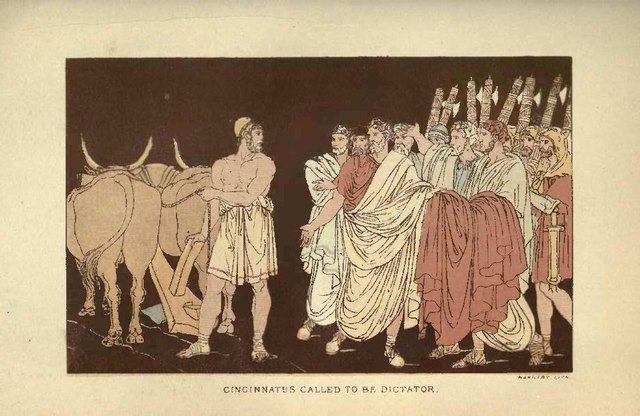The Early Roman Republic
October 31st 2023
1700 words

Intro
After the Roman Regal era, came the Roman Republic. The Roman Republic can be divided into an early, middle, and late period. To begin with, I am going to explore the early Roman Republic. This isn't going to be an exhaustive look, but at least a look into this period enough to give a simplistic history. I have already looked into the Roman Regal period and suggest you look at that post as well.Founding of Rome’s Republic
First, let's look at the founding of Roman Republic. It started when the last Roman king, Lucius Tarquinius Superbus (Tarquin the Proud), son, Sextus Tarquinius raped Lucretia. She, in turn, killed herself. Her husband, Lucius Tarquinius Collatinus, and his nephew, Lucius Junius Brutus, gained support from the aristocracy and overthrew Tarquin the Proud. Tarquin was then exiled into the Etruria area after being overthrown. This was seen as more of an aristocratic coup rather than a popular uprising. While this story helps explain the founding of the Roman Republic, it is considered by historians to be largely mythological.The powers of the king were given to a new position known as the consuls. Two consuls were elected by the senate, instead of just one. They each held a term of one year. They were given the ability to veto, or override, each other's decisions. The consuls were then the head of the government instead of a Rex or king monarch. The first consuls were Collatinus and Brutus.
Rome’s Beginnings Filled with War
Rome's Republic wasn’t necessarily founded in a time of peace for Rome. In fact, Rome was founded and right off the bat wars began with the Etruscans and Sabine people. Some historians actually believe that the Roman Republic was founded due to occupation of Rome by the Etruscans. As for the Sabine wars, the senate passed a Senatus Consultum. It authorized a dictator to take control of the military. Thus, stopping any possible infighting between two different consuls. In fact, a dictator will be appointed throughout Rome's history during times of emergency. The ruling dictator would, in turn, appoint a Magister Equitum, which is basically a head of the calvary.Tarquin’s Last Attempt
A particularly important battle happened at the beginning of the 5th century BCE, the Battle of Lake Regulus. This battle is traditionally dated at 496bce but has been attributed to dates ranging from 499bce to 489bce. The Battle of Lake Regulus involved the powerful Latin League, a league of non-roman Latin cities, along with the exiled Tarquin the Proud. Throughout Tarquin the Proud's exile he teamed up with different states to try and reclaim his kingship in Rome. This battle marked the last attempt by Tarquin to regain control of Rome. This battle saw the defeat of the Latin League. Some may argue that this is the point that Rome officially threw off its baggage of the monarchy and became its own republic.The Conflict of Orders Begins
While Rome is known for its foreign adventures, there was internal history being made along the same time frame. The beginning of the 'conflict of orders,' began during this time. The conflict of orders is the dispute between the noble patricians and the average plebians. Around 494bce an event known as the first secessio plebis took place. First, let me give a little background as to what led up to the event, before explaining what the first secessio plebis is and what was accomplished.The Background to the First Secessio Plebis
The events that led up to the first secessio plebis began somewhere around 495bce. You will notice that there aren’t concrete dates for a lot of these events. This is because of conflicting accounts of said events. There was a situation where money lenders would give money to poor plebs in order to help them out. However, when the plebs were unable to pay off their debt, the money lenders would imprison them and beat them as punishment. As one would imagine, this caused discontent within the plebian people. They desired relief from this poor treatment. This culminated when a veteran that fought for Rome gave an impassioned speech at the Roman forum and showed his scares caused by money lenders. This caused the plebian people to be outraged.During this back and forth between the plebs and the aristocracy there was foreign threats to Rome. In order to shore up numbers for the military, the consul released the debted plebs so they could join the military to fight off the threat. Once the threat was gone, many thought they would remain free. Sadly, they were handed right back to their debt holders. This caused outrage amongst the plebs and led to the first secessio plebis.
The First Secessio Plebis
Around 494bce, a leading pleb, Lucius Sicinius Vellutus, led the plebs to secede from Rome, relocating to the sacred Monte Sacro. As one would expect, this harmed the military capability of Rome to defend itself and negatively impacted Roman economic capacity. Finally, after much negotiations, the Roman aristocracy was able to cut a deal with the plebs. The plebs were given representation within the Roman government in the form of the tribune of the plebs. The number of tribunes is a bit debated, but it was somewhere between 2 to 5. In 459bce this number was increased to 10.Cincinnatus Dictatorship Part 1
Next, lets discuss the historical figure, Cincinnatus. Cincinnatus was given dictatorship in around 458bce. He fought against the foreign threat caused by the Aequi in the East. The Aequi had broken their treaty with Rome, attacking Rome itself. Cincinnatus was given full power of Rome to deal with the Aequi threat. Cincinnatus decisively put down the threat. This is not what necessarily made him such a famous figure to the Romans, though. He was given the power to be dictator for six months. However, he dealt with the Aequi within 15 or 16 days. Instead of holding onto power, he gave it up once the threat was gone, and retired back to his farmland. This selfless act of giving up such power, branded his name into history.The Conflict of Orders Continues
The conflict of orders continued, even with foreign threats. Most plebs were demanding a written set of laws, so that punishments could be, to some degree, equally handed down. After traveling around and observing what other countries had as their laws, a group of roman scholars finally achieved a sensible understanding of governance of laws. The first written Roman laws were known as the twelve tables passed in 450bce. It covered numerous logistics such as property rights and procedures. Around 10 years later in 440bce, the lex cannuleia passed, forcing the patricians to follow the same laws as the plebs.This was not the only victory for the plebs during this time. The Tribal Assembly was also established. The Tribal Assembly was an assembly of all the different tribes being represented. Each tribe was given one vote, no matter size or importance. They were granted the right to elect quaestors, which were essentially public officials. The lex canuleia was also passed during this period, allowing patricians and plebians to marry under roman law. Finally, the position of the censor was created in order to conduct a census of the population, usually when there wasn’t a consul to do so.
